Preparation and Characterization of PU/PET Matrix Gradient Composites with Microwave-Absorbing Function
Abstract
:1. Introduction
2. Materials and Methods
2.1. Materials and Specimen Preparation
2.1.1. Microwave-Absorbing Film
2.1.2. Microwave-Absorbing Impregnated Nonwoven Fabric
2.2. Test Equipment and Methods
3. Experiment Results and Discussion
3.1. General Performance
3.1.1. SEM Images
3.1.2. Tensile Property
3.1.3. Adhesion
3.1.4. Optical Density and Transmittance
3.1.5. Antistatic Property
3.1.6. Selection of Filling Scheme
3.2. Microwave-Absorbing Property
3.2.1. Gradient Absorbing Structure
3.2.2. Influence of Mass Ratio of Fe3O4/CNTs on Microwave-Absorbing Property
4. Conclusions
- Microwave-absorbing powder can significantly improve a film’s tensile property. When Fe3O4 and CNTs are combined in usage of a filler, the tensile strength of the film reaches a maximum value of 9.35 MPa. When CIP and CNTs are mixed as fillers, the breaking elongation of the film reaches the maximum, which is 267.46%. CNTs can increase the adhesion level of coating film, while the other microwave-absorbing powders will help enhance the coating adhesion. The antistatic property of films in the single-factor process groups is similar to that of pure PU film, which is similar to semiconductor. The loading of CNTs in PU film significantly reduces the surface resistance, so that the functional PU films loaded with CNTs is similar to conductor.
- The combination of Fe3O4 and CNTs can effectively improve the mechanical properties of PU film. For example, the tensile strength is 193.15% higher than that of the control group F1, and 79.46% higher than that of the single factor process group F3.
- The mass ratio of CNTs and Fe3O4 has a significant impact on the microwave-absorbing properties of PU/PET matrix gradient composites. In the Ku-band, when the mass ratio of CNTs and Fe3O4 is 1:1, the PU/PET matrix microwave-absorbing composite in the thickness of 1 mm has a maximum reflection loss of −17.19 dB. When the mass ratio of CNTs and Fe3O4 is more than or less than 1:1, PU/PET matrix gradient composites show poor microwave-absorbing performance.
- The Fe3O4/CNTs/PU/PET matrix gradient composite was easily fabricated with needle punched nonwoven and shown notable electromagnetic absorbing performance, indicating the great prospects of gradient nonwovens in electromagnetic absorbing fields.
- The Fe3O4/CNTs/PU/PET matrix gradient composite was easily fabricated with needle punched nonwoven and shown notable absorbing performance, indicating the great prospects of gradient nonwovens in electromagnetic absorbing fields. Our current work tries to clarify the macro performance of different PU/PET matrix gradient composites with microwave-absorbing function. Further research involving the relationship between different structure forms at micro-level, meso-level and macro-level will be conducted in the future.
Author Contributions
Funding
Institutional Review Board Statement
Informed Consent Statement
Data Availability Statement
Conflicts of Interest
References
- Wanasinghe, D.; Aslani, F.; Ma, G. Electromagnetic shielding properties of carbon fibre reinforced cementitious composites. Constr. Build. Mater. 2020, 260, 120439. [Google Scholar] [CrossRef]
- Yang, J.; Liao, X.; Wang, G.; Chen, J.; Guo, F.; Tang, W.; Wang, W.; Yan, Z.; Li, G. Gradient structure design of lightweight and flexible silicone rubber nanocomposite foam for efficient electromagnetic interference shielding. Chem. Eng. J. 2020, 390, 124589. [Google Scholar] [CrossRef]
- Jia, Z.; Lan, D.; Lin, K.; Qin, M.; Kou, K.; Wu, G.; Wu, H. Progress in low-frequency microwave absorbing materials. J. Mater. Sci. Mater. Electron. 2018, 29, 17122–17136. [Google Scholar] [CrossRef]
- Zhan, J.; Yao, Y.; Zhang, C.; Li, C. Synthesis and microwave absorbing properties of quasione-dimensional mesoporous NiCo2O4 nanostructure. J. Alloys Compd. 2014, 585, 240–244. [Google Scholar] [CrossRef]
- Gao, Y.; Gao, X.; Li, J.; Guo, S. Improved microwave absorbing property provided by the filler’s alternating lamellar distribution of carbon nanotube/carbonyl iron/poly (vinyl chloride) composites. Compos. Sci. Technol. 2018, 158, 175–185. [Google Scholar] [CrossRef]
- Zheng, X.; Hu, Q.; Wang, Z.; Nie, W.; Wang, P.; Li, C. Roll-to-roll layer-by-layer assembly bark-shaped carbon nanotube/Ti3C2Tx MXene textiles for wearable electronics. J. Colloid Interface Sci. 2021, 602, 680–688. [Google Scholar] [CrossRef]
- Savi, P.; Giorcelli, M.; Quaranta, S. Multi-walled carbon nanotubes composites for microwave absorbing applications. Appl. Sci. 2019, 9, 851. [Google Scholar] [CrossRef] [Green Version]
- Song, X.; Li, X.; Yan, H. Preparation and microwave absorption properties of MWCNTs/Fe3O4/NBR composites. Diam. Relat. Mater. 2019, 100, 107573. [Google Scholar] [CrossRef]
- Zhao, T.; Jin, W.; Ji, X.; Yan, H.; Jiang, Y.; Dong, Y.; Yang, Y.; Dang, A.; Li, H.; Li, T.; et al. Synthesis of sandwich microstructured expanded graphite/barium ferrite connected with carbon nanotube composite and its electromagnetic wave absorbing properties. J. Alloys Compd. 2017, 712, 59–68. [Google Scholar] [CrossRef] [Green Version]
- Singh, S.K.; Akhtar, M.J.; Kar, K.K. Hierarchical carbon nanotube-coated carbon fiber: Ultra, lightweight, thin, and highly efficient microwave absorber. ACS Appl. Mater. Interfaces 2018, 10, 24816–24828. [Google Scholar] [CrossRef]
- Li, N.; Huang, G.; Li, Y.; Xiao, H.; Feng, Q.; Hu, N.; Fu, S. Enhanced microwave absorption performance of coated carbon nanotubes by optimizing the Fe3O4 nanocoating structure. ACS Appl. Mater. Interfaces 2017, 9, 2973–2983. [Google Scholar] [CrossRef]
- Singh, S.K.; Akhtar, M.J.; Kar, K.K. Impact of Al2O3, TiO2, ZnO and BaTiO3 on the microwave absorption properties of exfoliated graphite/epoxy composites at X-band frequencies. Compos. Part B Eng. 2019, 167, 135–146. [Google Scholar] [CrossRef]
- Wang, L.; Jia, X.; Li, Y.; Yang, F.; Zhang, L.; Liu, L.; Ren, X.; Yang, H. Synthesis and microwave absorption property of flexible magnetic film based on graphene oxide/carbon nanotubes and Fe3O4 nanoparticles. J. Mater. Chem. A 2014, 2, 14940–14946. [Google Scholar]
- Jacobo, S.E.; Aphesteguy, J.C.; Anton, R.L.; Schegoleva, N.N.; Kurlyandskay, G.V. Influence of the preparation procedure on the properties of polyaniline based magnetic composites. Eur. Polym. J. 2007, 43, 1333–1346. [Google Scholar] [CrossRef]
- Yuvchenko, A.A.; Lepalovskii, V.N.; Vas’kovskii, V.O.; Safronov, A.P.; Volchkov, S.O.; Kurlyandskaya, G.V. Magnetic impedance of structured film meanders in the presence of magnetic micro- and nanoparticles. Tech. Phys. 2014, 59, 230–236. [Google Scholar] [CrossRef]
- Zamani Kouhpanji, M.R.; Stadler, B.J.H. A guideline for effectively synthesizing and characterizing magnetic nanoparticles for advancing nanobiotechnology: A review. Sensors 2020, 20, 2554. [Google Scholar] [CrossRef] [PubMed]
- Aphesteguy, J.C.; Jacobo, S.E.; Lezama, L.; Kurlyandskaya, G.V.; Schegoleva, N.N. Microwave resonant and zero-field absorption study of doped magnetite prepared by a co-precipitation method. Molecules 2014, 19, 8387–8401. [Google Scholar] [CrossRef] [Green Version]
- Ansari, S.A.M.K.; Ficiarà, E.; Ruffinatti, F.A.; Stura, I.; Argenziano, M.; Abollino, O.; Cavalli, R.; Guiot, C.; D’Agata, F. Magnetic iron oxide nanoparticles: Synthesis, characterization and functionalization for biomedical applications in the central nervous system. Materials 2019, 12, 465. [Google Scholar] [CrossRef] [Green Version]
- Kaczmarek, K.; Hornowski, T.; Dobosz, B.; Józefczak, A. Influence of magnetic nanoparticles on the focused ultrasound hyperthermia. Materials 2018, 11, 1607. [Google Scholar] [CrossRef] [Green Version]
- Bi, S.; Tang, J.; Wang, D.J.; Su, Z.A.; Hou, G.L.; Li, H.; Li, J. Lightweight non-woven fabric graphene aerogel composite matrices for assembling carbonyl iron as flexible microwave absorbing textiles. J. Mater. Sci. Mater. Electron. 2019, 30, 17137–17144. [Google Scholar] [CrossRef]
- Egami, Y.; Yamamoto, T.; Suzuki, K.; Yasuhara, T.; Higuchi, E.; Inoue, H. Stacked polypyrrole-coated non-woven fabric sheets for absorbing electromagnetic waves with extremely high frequencies. J. Mater. Sci. 2012, 47, 382–390. [Google Scholar] [CrossRef]
- ISO 527-3:1995. Plastics-Determination of Tensile Properties Part 3: Test Conditions for Films and Sheets; International Organization for Standardization: Geneva, Switzerland, 1995. [Google Scholar]
- ASTM D3359-09. Standard Test Methods for Measuring Adhesion by Tape Test; American Society for Testing and Materials: West Conshohocken, PA, USA, 2009. [Google Scholar]
- JJG920-2017. Diffuse Transmission Visual Densitometers; National Optical Metrology Technical Committee: Beijing, China, 2017. (In Chinese) [Google Scholar]
- GJB 2038A-2011. The measurement Methods for Reflectivity of Radar Absorbing Material; General Assembly Electronic Information Basic Department: Beijing, China, 2011. (In Chinese) [Google Scholar]
- Jiang, S.; Hou, P.; Chen, M.; Wang, B.; Sun, D.; Tang, D.; Jin, Q.; Guo, Q.; Zhang, D.; Du, J.; et al. Ultrahigh-performance transparent conductive films of carbon-welded isolated single-wall carbon nanotubes. Sci. Adv. 2018, 4, eaap9264. [Google Scholar] [CrossRef] [PubMed] [Green Version]
- Wang, D.; Wu, Z.; Li, F.; Gan, X.; Tao, J.; Yi, J.; Liu, Y. A combination of enhanced mechanical and electromagnetic shielding properties of carbon nanotubes reinforced Cu-Ni composite foams. Nanomaterials 2021, 11, 1772. [Google Scholar] [CrossRef] [PubMed]
- Kim, H.-J.; Kim, S.-H.; Park, S. Effects of the carbon fiber-carbon microcoil hybrid formation on the effectiveness of electromagnetic wave shielding on carbon fibers-based fabrics. Materials 2018, 11, 2344. [Google Scholar] [CrossRef] [PubMed] [Green Version]
- Ulloa-Castillo, N.A.; Martínez-Romero, O.; Hernandez-Maya, R.; Segura-Cárdenas, E.; Elías-Zúñiga, A. Spark plasma sintering of aluminum-based powders reinforced with carbon nanotubes: Investigation of electrical conductivity and hardness properties. Materials 2021, 14, 373. [Google Scholar] [CrossRef]




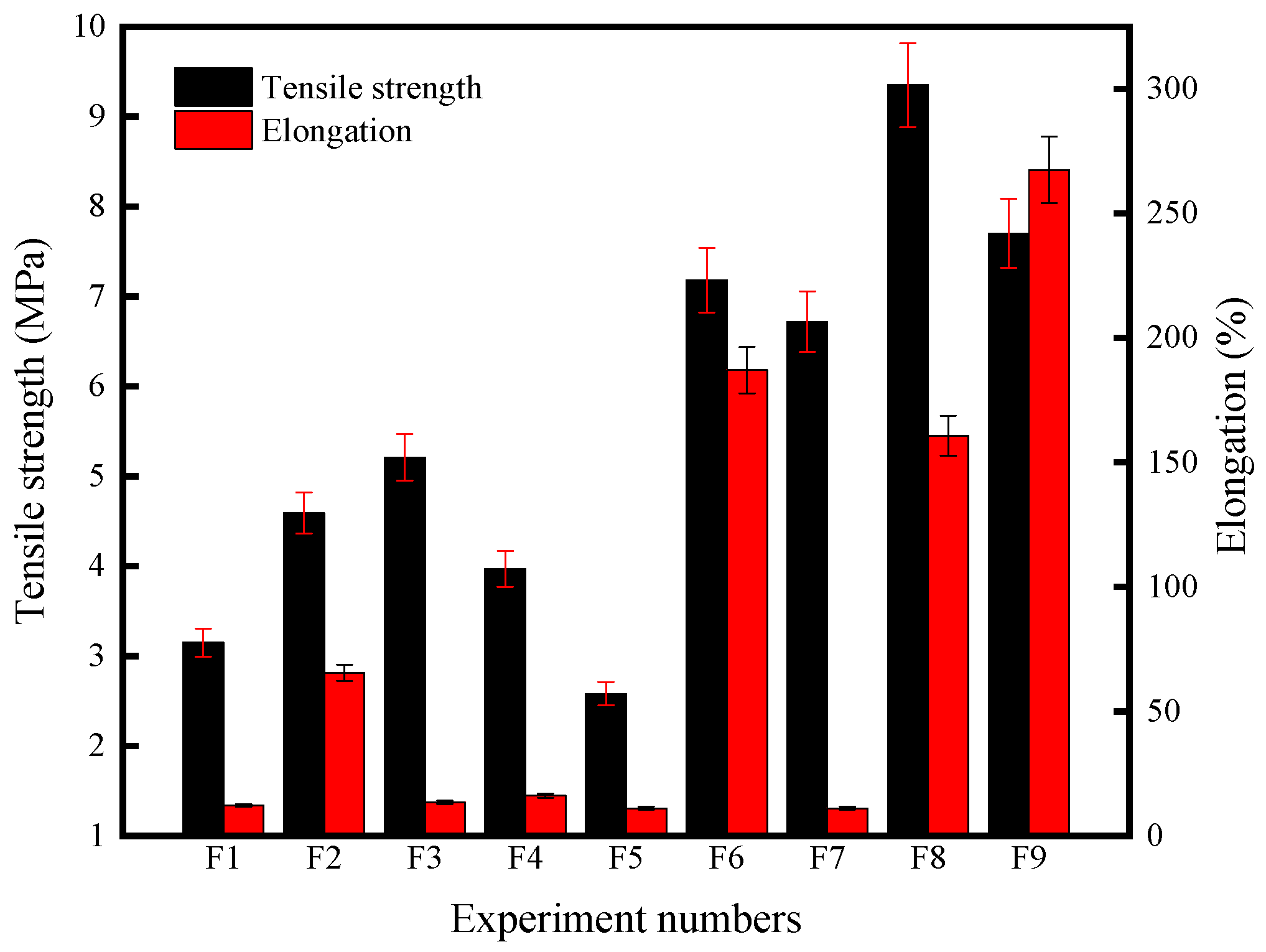
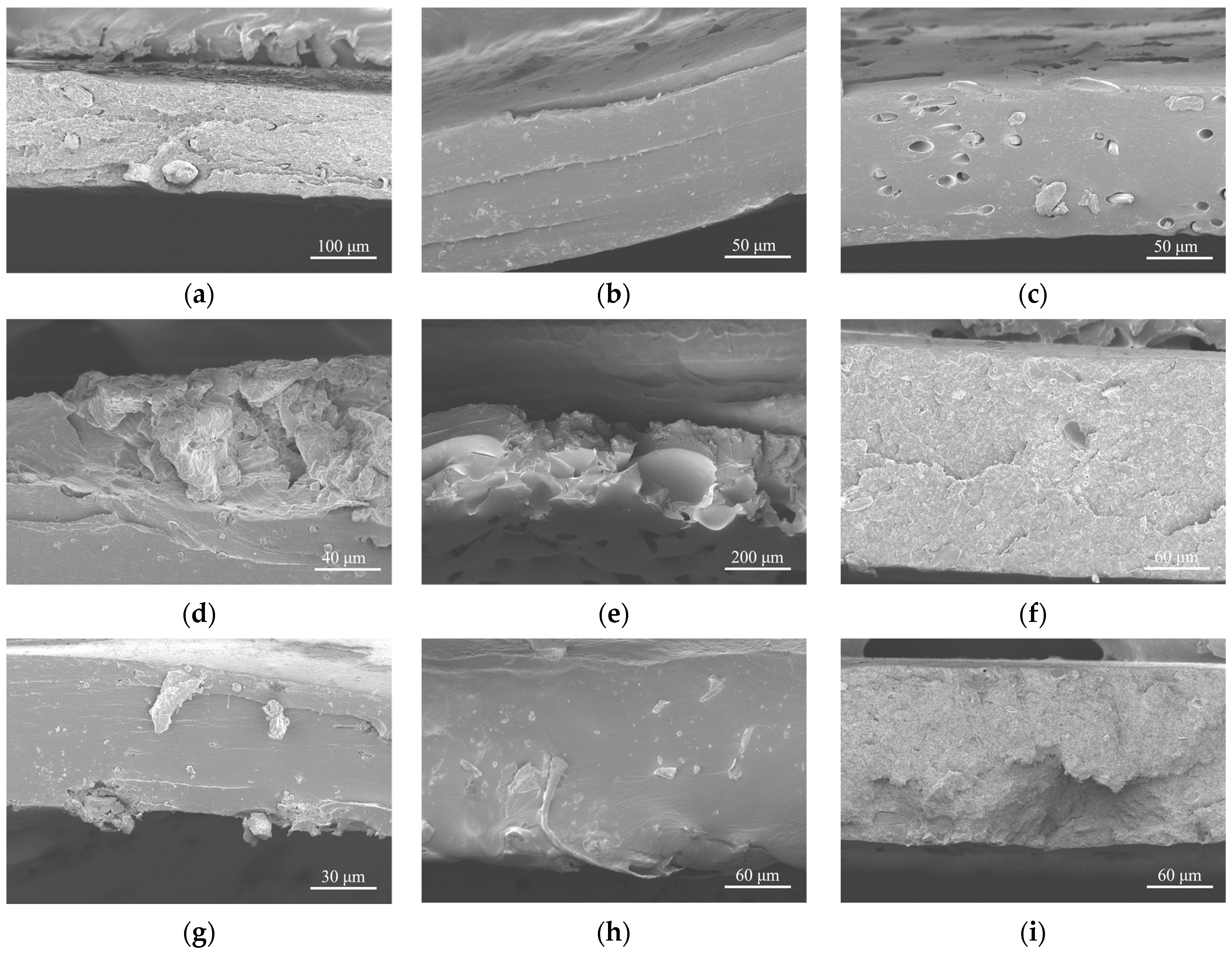
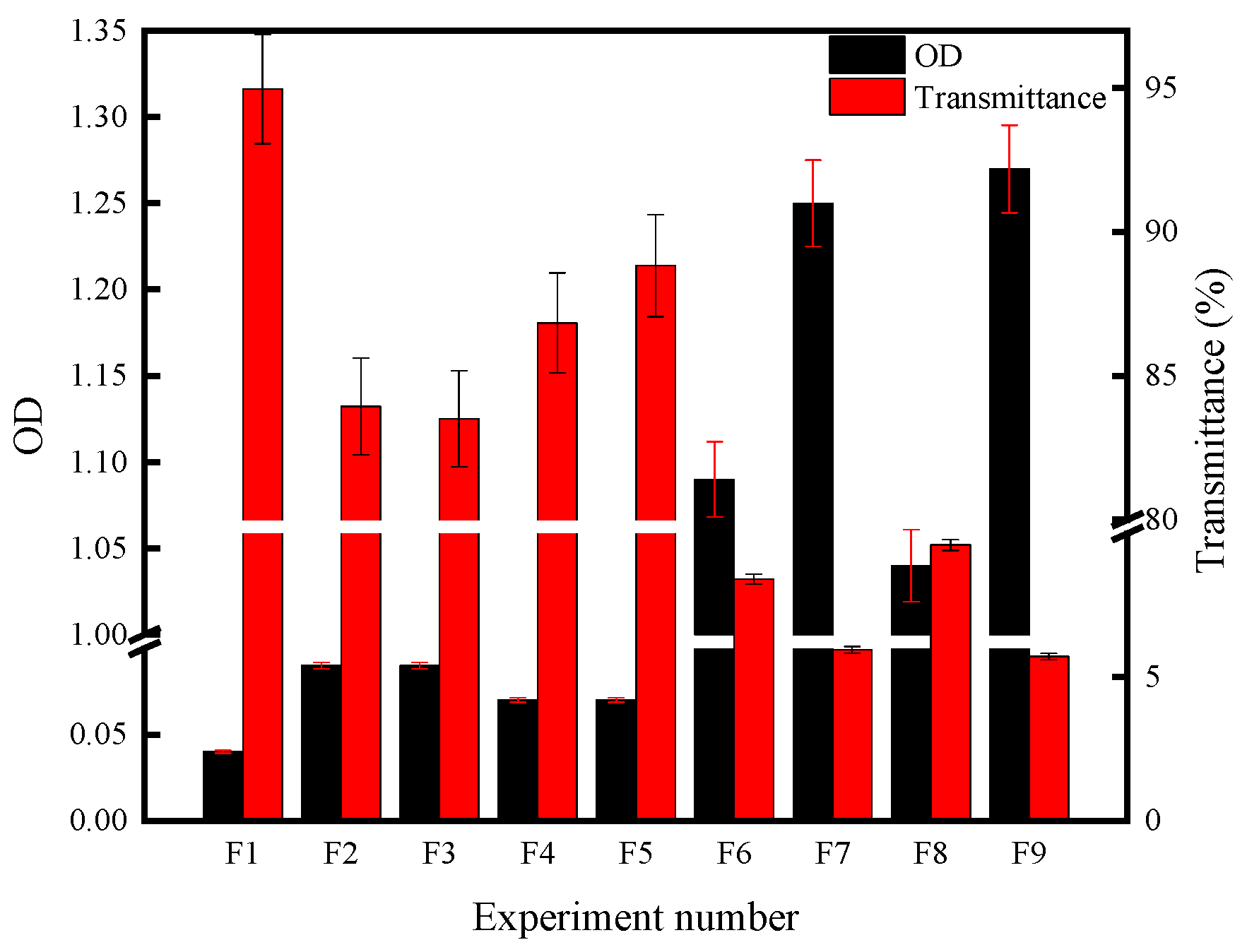
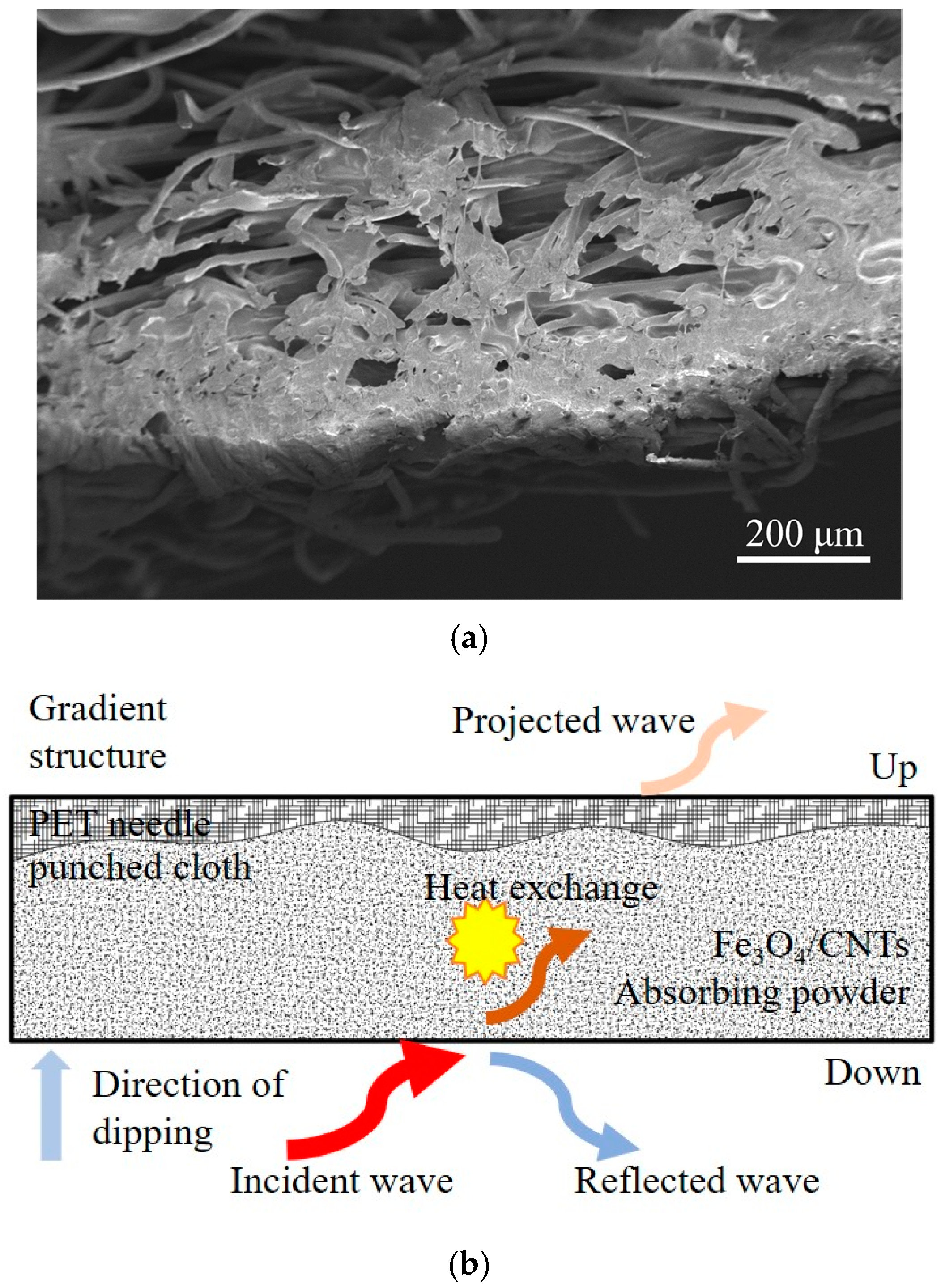

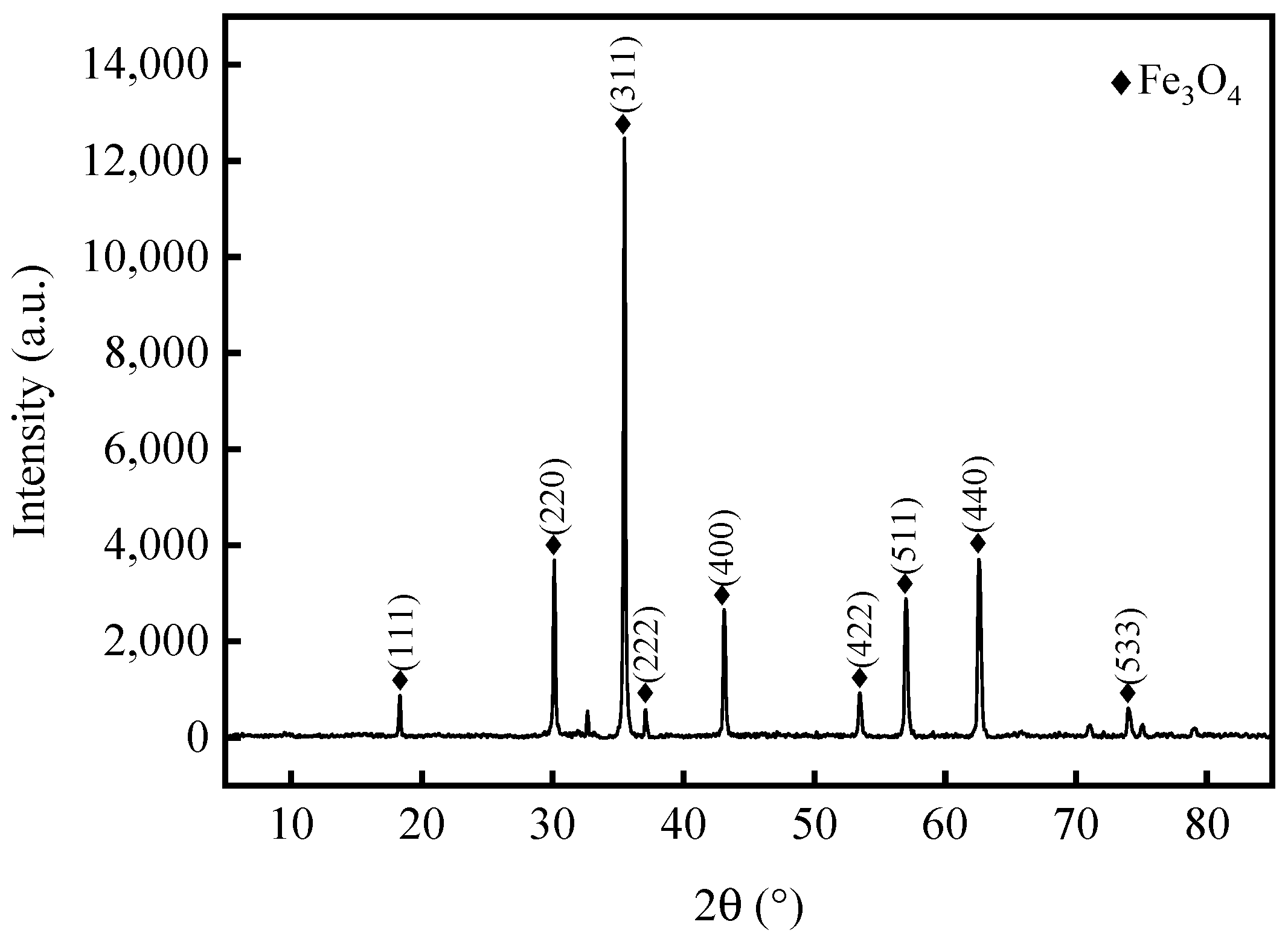


| Experiment Number | Group | Absorbing Powder 1/(wt.%) | Absorbing Powder 2/(wt.%) | PU/(wt.%) |
|---|---|---|---|---|
| F1 | Control group | - | - | 100 |
| F2 | Single factor process group | Graphite/1.5 | - | 100 |
| F3 | CFs/1.5 | - | 100 | |
| F4 | Fe3O4/1.5 | - | 100 | |
| F5 | CIP/1.5 | - | 100 | |
| F6 | Two-factors process group | Graphite/1.5 | CNTs/1.5 | 100 |
| F7 | CFs/1.5 | CNTs/1.5 | 100 | |
| F8 | Fe3O4/1.5 | CNTs/1.5 | 100 | |
| F9 | CIP/1.5 | CNTs/1.5 | 100 |
| Experiment Number | Level |
|---|---|
| F1 | 3 |
| F2 | 1 |
| F3 | 1 |
| F4 | 2 |
| F5 | 2 |
| F6 | 4 |
| F7 | 3 |
| F8 | 3 |
| F9 | 4 |
| Experiment Number | Surface Resistance (Ω) | Antistatic Property |
|---|---|---|
| F1 | 109 | Semiconductor |
| F2 | 109 | Semiconductor |
| F3 | 1011 | Semiconductor |
| F4 | 1011 | Semiconductor |
| F5 | 1011 | Semiconductor |
| F6 | 104 | Conductor |
| F7 | 105 | Conductor |
| F8 | 105 | Conductor |
| F9 | 104 | Conductor |
| Experiment Number | CNTs/(wt.%) | Fe3O4/(wt.%) | PU/(wt.%) |
|---|---|---|---|
| F10 | 1.5 | 2.25 | 100 |
| F11 | 1.5 | 1.5 | 100 |
| F12 | 1.5 | 0.75 | 100 |
Publisher’s Note: MDPI stays neutral with regard to jurisdictional claims in published maps and institutional affiliations. |
© 2021 by the authors. Licensee MDPI, Basel, Switzerland. This article is an open access article distributed under the terms and conditions of the Creative Commons Attribution (CC BY) license (https://creativecommons.org/licenses/by/4.0/).
Share and Cite
Gu, W.; Zhan, R.; Li, R.; Liu, J.; Zhang, J. Preparation and Characterization of PU/PET Matrix Gradient Composites with Microwave-Absorbing Function. Coatings 2021, 11, 982. https://doi.org/10.3390/coatings11080982
Gu W, Zhan R, Li R, Liu J, Zhang J. Preparation and Characterization of PU/PET Matrix Gradient Composites with Microwave-Absorbing Function. Coatings. 2021; 11(8):982. https://doi.org/10.3390/coatings11080982
Chicago/Turabian StyleGu, Wenyan, Rong Zhan, Rui Li, Jiaxin Liu, and Jiaqiao Zhang. 2021. "Preparation and Characterization of PU/PET Matrix Gradient Composites with Microwave-Absorbing Function" Coatings 11, no. 8: 982. https://doi.org/10.3390/coatings11080982
APA StyleGu, W., Zhan, R., Li, R., Liu, J., & Zhang, J. (2021). Preparation and Characterization of PU/PET Matrix Gradient Composites with Microwave-Absorbing Function. Coatings, 11(8), 982. https://doi.org/10.3390/coatings11080982






